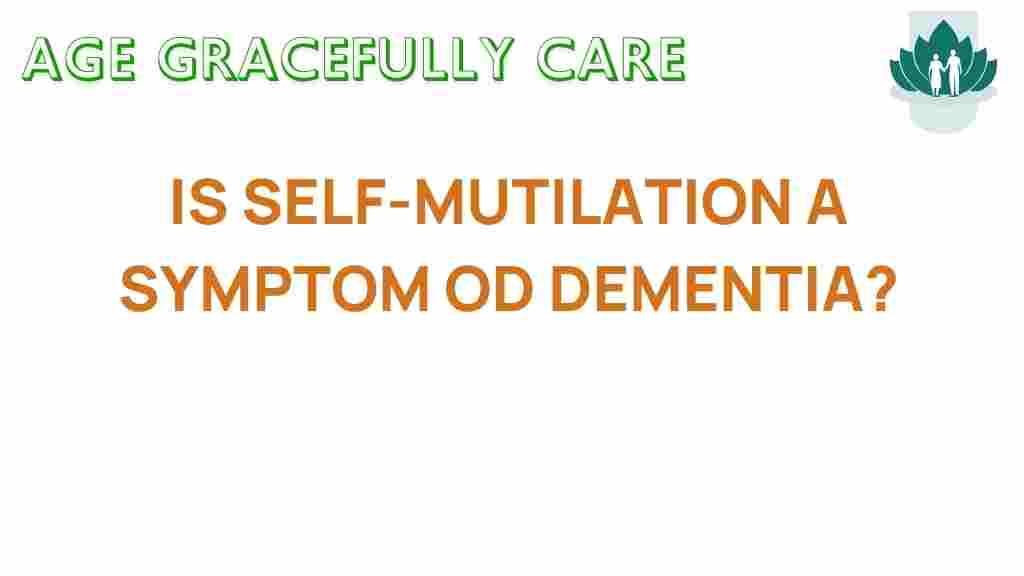Unraveling the Mystery: Is Self-Mutilation a Symptom of Dementia?
Dementia is a complex neurological disorder that affects millions of elderly individuals worldwide. As the population ages, understanding the various symptoms associated with dementia becomes increasingly important. Among these symptoms, self-mutilation is a concerning behavior that may arise in some patients. This article will delve into the relationship between self-mutilation and dementia, exploring the underlying causes, its implications for mental health, and the best approaches for caregiving.
Understanding Dementia and Its Symptoms
Dementia is not a single disease but a term that encompasses a range of neurological disorders that lead to cognitive decline. The most common types of dementia include Alzheimer’s disease, vascular dementia, and Lewy body dementia. Each type presents unique symptoms, but common behavioral symptoms include:
- Memory loss
- Difficulty with communication
- Changes in mood and personality
- Disorientation to time and place
- Self-neglect and withdrawal from social interactions
Understanding these symptoms is crucial for effective elderly care and can help caregivers provide better support to their loved ones.
What is Self-Mutilation?
Self-mutilation, also known as self-harm, refers to the intentional act of causing harm to one’s own body. This behavior can manifest in various forms, such as cutting, burning, or hitting oneself. While commonly associated with younger individuals dealing with emotional distress, self-mutilation can also occur in elderly patients, particularly those with cognitive impairments like dementia.
Self-mutilation in dementia patients may stem from various factors, including:
- Inability to communicate distress or discomfort
- Frustration due to cognitive decline
- Physical pain or discomfort that cannot be expressed
- Confusion and agitation
Linking Self-Mutilation and Dementia
Research suggests that self-mutilation can be a behavioral symptom of dementia, although it is not universally present in all patients. Understanding the connection between self-mutilation and dementia is essential for effective psychological assessment and intervention.
Key factors that may contribute to self-mutilation in dementia patients include:
- Neurological Changes: As the brain deteriorates, it may lead to changes in behavior, including impulsivity and aggression.
- Emotional Distress: Patients may experience feelings of confusion, fear, or frustration that they cannot articulate, leading to self-harming behaviors.
- Physical Discomfort: Some patients may experience unrecognized pain or discomfort, prompting them to harm themselves as a way to cope.
Behavioral Symptoms in Dementia Patients
Behavioral symptoms can often pose a significant challenge in managing dementia patients. Self-mutilation is one of many behaviors that caregivers may encounter. Other common behavioral symptoms include:
- Agitation or aggression
- Wandering
- Repetitive questioning
- Social withdrawal
- Sleep disturbances
Recognizing these symptoms early is crucial for effective caregiving. It allows caregivers to implement appropriate strategies to manage patient behavior and enhance quality of life.
Step-by-Step Approach to Managing Self-Mutilation
If self-mutilation is observed in a dementia patient, a systematic approach is vital for addressing the behavior. Here is a step-by-step guide:
1. Observe and Document
Carefully monitor the patient’s behavior. Document instances of self-mutilation, noting:
- Frequency of the behavior
- Context or triggers that precede the behavior
- Any accompanying symptoms (e.g., agitation, distress)
2. Conduct a Psychological Assessment
A thorough psychological assessment should be conducted to identify any underlying causes of self-mutilation. This may involve:
- Consulting with a psychologist or psychiatrist
- Evaluating the patient’s medical history
- Assessing for pain or discomfort
3. Address Underlying Issues
Once the assessment is complete, work on addressing any identified issues. This may include:
- Adjusting medications if necessary
- Implementing pain management strategies
- Providing psychological support or therapy
4. Create a Safe Environment
Ensure the patient’s environment is safe and conducive to their well-being. This can involve:
- Removing sharp objects or potential hazards
- Creating a calm and structured daily routine
- Establishing a supportive and comforting atmosphere
5. Involve Professional Help
In some cases, it may be necessary to involve healthcare professionals, such as:
- Occupational therapists
- Physical therapists
- Mental health professionals
These professionals can provide additional strategies and support for managing self-mutilation and other behavioral symptoms.
Troubleshooting Tips for Caregivers
Caring for a dementia patient exhibiting self-mutilation can be challenging. Here are some troubleshooting tips for caregivers:
- Stay Calm: Maintain a calm demeanor when the patient displays self-mutilation. Your reaction can influence their behavior.
- Provide Distractions: Engage the patient in activities they enjoy to divert their attention from self-harm.
- Communicate Clearly: Use simple language and clear instructions to avoid confusion.
- Seek Support: Connect with other caregivers or support groups to share experiences and solutions.
For additional resources, consider exploring caregiver support networks that can provide valuable assistance.
Conclusion
Self-mutilation can be a distressing behavioral symptom of dementia, highlighting the complexities of mental health in elderly care. Understanding the relationship between self-mutilation and dementia is crucial for caregivers and healthcare professionals alike. By observing behaviors, conducting thorough assessments, and implementing effective management strategies, caregivers can significantly improve the quality of life for dementia patients.
As we continue to unravel the mysteries of dementia, it is essential to remain vigilant and compassionate, recognizing the unique needs of each individual. By prioritizing mental health and patient care, we can create a supportive environment for those affected by neurological disorders.
For more information on dementia care and behavioral symptoms, visit this informative resource.
This article is in the category Health and created by AgeGracefullyCare Team
